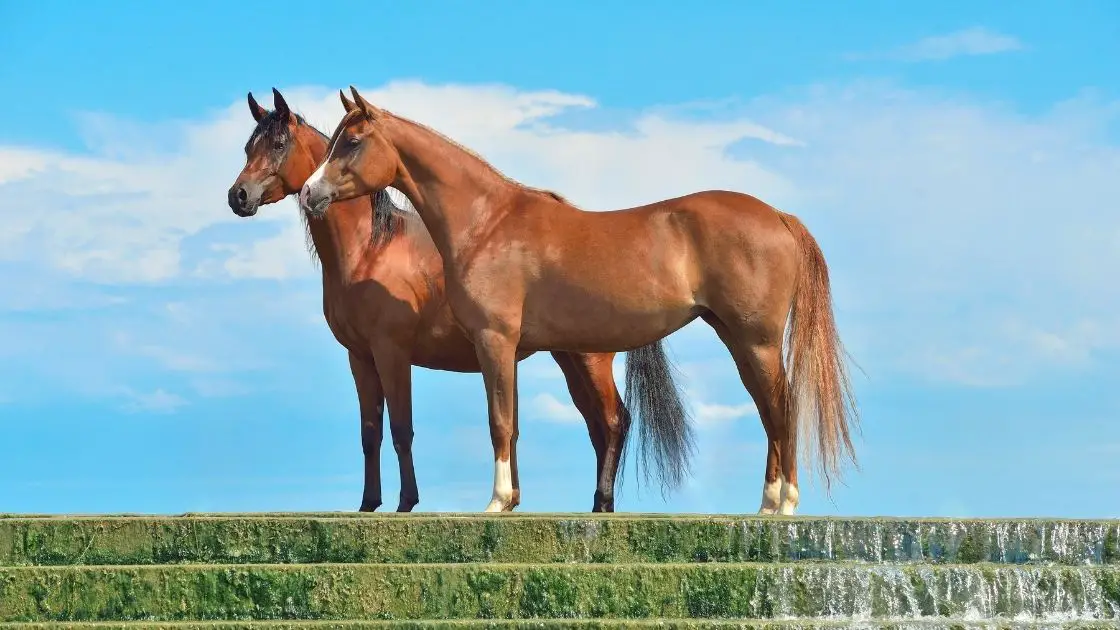Horses cannot safely go down stairs due to their physical structure and coordination limitations. However, they are skilled at navigating sloping terrain and can handle steep inclines and declines with proper training and guidance.
Horses are magnificent creatures, renowned for their strength, agility, and ability to conquer various terrains. However, when it comes to navigating stairs, their capabilities are limited. Due to their physical structure and lack of coordination for precise stepping, horses cannot safely descend stairs.
Although they possess remarkable skills in traversing sloping terrain, going down a flight of stairs is beyond their capabilities. Nevertheless, with appropriate training and guidance, these majestic animals can confidently handle steep inclines and declines. This article explores the reasons behind horses’ inability to maneuver stairs and delves into their exceptional adaptability when faced with other challenging landscapes.

Credit: horsebondingsuccess.com
Why Horses And Stairs Don’t Mix Well
The impact of a horse’s anatomy on navigating stairs is one of the primary reasons why horses and stairs don’t mix well. Horses are naturally built for wide open spaces and have a difficult time maneuvering on uneven, narrow staircases. Their long legs and heavy bodies can make it challenging for them to maintain their balance and coordination, increasing the risk of injury to both the horse and rider. The strain placed on a horse’s joints and tendons when going down stairs can also lead to long-term damage and lameness. Additionally, the horse’s size and weight make it more challenging to control their descent, putting both themselves and their rider at risk. For these reasons, it is highly recommended to avoid attempting to navigate stairs with a horse to ensure the safety and well-being of all parties involved.
Myths And Misconceptions About Horses And Stairs
Contrary to popular belief, horses are generally not capable of going down stairs. Despite their agility and strength, the equine anatomy poses several challenges when it comes to navigating steps. One major factor is their natural conformation, which is designed for running and grazing on open terrain rather than descending steep inclines. The horse’s front legs are structured to support weight and provide propulsion, making it difficult for them to safely and comfortably place their front legs on a step without straining their joints. Additionally, their size and weight distribution creates a higher risk of injury while attempting to go down stairs.
Addressing common beliefs about horses and stairs, it is important to debunk the misconception that horses can maneuver stairs effortlessly. While some videos and images may circulate online appearing to show horses descending stairs, it is crucial to understand that these situations are rare and often involve specially trained horses and controlled environments. It is essential to prioritize the well-being and safety of horses by avoiding situations that put them at risk, such as attempting to navigate stairs.
The Science Behind Horse’s Inability To Go Down Stairs
When it comes to stair navigation, horses face limitations due to their anatomy and physiology. The biomechanics of horse movement play a significant role in this inability.
Horses are built for horizontal movement, with their powerful legs and long strides enabling them to gallop and jump over obstacles. However, their anatomy is not well-suited for vertical movement, such as going down stairs.
Their long legs and heavy bodies make it challenging for them to maintain balance and distribute weight evenly when going down stairs. Additionally, their hind limbs are not designed to support the necessary weight and impact that occurs during stair descent. This can lead to increased stress on their joints and potential injuries.
In addition to anatomical limitations, horses rely on their binocular vision for depth perception. This means they have difficulty accurately judging the depth of each stair, further hindering their ability to navigate them safely.
Overall, the combination of their anatomical structure, limited weight-bearing capacity, and depth perception challenges makes it unsafe for horses to go down stairs. Their natural agility and athleticism are better suited for flat terrain and natural obstacles found in their natural environments.
Alternatives To Stairs For Horses
Horses, like any other animals, may face challenges when it comes to accessing different levels. Fortunately, there are practical solutions available that allow them to bridge heights without relying on stairs. These innovative means not only ensure safety but also promote convenience.
One alternative to stairs for horses is the use of ramps. Ramps provide a gradual incline that horses can easily navigate, allowing them to move between levels without the risk of tripping or slipping. Ramps can be made from sturdy materials such as wood or metal, ensuring durability and stability.
Another option is the installation of horse lifts or elevators. These mechanical devices provide a vertical transport system, allowing horses to access higher or lower levels effortlessly. Horse lifts are designed with safety features such as non-slip surfaces and stable platforms, ensuring a secure and comfortable experience for the animal.
Additionally, some architectural designs incorporate gentle slopes or graded pathways to accommodate horses. These sloping paths provide a natural and visually appealing alternative to stairs, allowing horses to move freely without obstacles.
When it comes to ensuring the accessibility of different levels for horses, it is important to consider practical and innovative alternatives. Ramps, horse lifts, and graded pathways offer safe and efficient solutions that ensure the ease of movement for these magnificent animals.
Historical Cases Of Horses Going Down Stairs
Examining rare instances of horses navigating stairs
Historical records and eyewitness accounts provide fascinating insights into the ability of horses to navigate staircases. Notably, several instances from different eras have demonstrated this unique skill.
One such occurrence dates back to the 16th century, during the reign of Queen Elizabeth I. It is said that one of her courtiers, Sir Philip Sidney, had a well-trained horse that could adeptly descend stairs in a seamless manner.
In a more recent occurrence, in the early 20th century, a remarkable photograph captured a horse gracefully descending the steps of a large stone mansion. The picture drew widespread attention and sparked debates about the possibility of horses effortlessly descending stairs.
These historical accounts, coupled with modern anecdotes, exemplify the agility and adaptability of horses, showcasing their ability to navigate stairs and conquer seemingly insurmountable obstacles. While such instances are undoubtedly rare, they shed light on the extraordinary capabilities of these magnificent creatures.
The Physical And Emotional Stress Of Stairs On Horses
The physical and emotional stress of stairs on horses can have a significant impact on their overall well-being. Horses are naturally cautious animals, and attempting to navigate stairs can be an intimidating experience for them. This can lead to a range of psychological effects, such as increased stress and fear.
Stress and fear can have a profound impact on horse behavior and performance. Horses may become hesitant, anxious, or even display signs of aggression when faced with the prospect of going down stairs. This can not only hinder their ability to navigate stairs safely, but it can also interfere with their overall training and performance.
It’s important for horse owners and trainers to understand the psychological effects that stairs can have on horses and to take steps to mitigate their impact. This can include slowly introducing horses to stairs in a controlled and positive manner, providing appropriate training and reinforcement, and ensuring that horses have a supportive and trusting environment in which to navigate stairs.
Training Techniques To Help Horses Navigate Uneven Terrain
htmlTraining horses to navigate uneven terrain, including stairs, requires a gradual exposure to different types of terrain. This helps build their confidence and trust. The key is to introduce them to various obstacles in a controlled manner, starting with simple ground-level obstacles and then progressing to more challenging ones.
One technique is to use desensitization exercises, such as having the horse walk over logs or tarps, which mimic uneven surfaces. This helps them become comfortable with different textures and sensations under their feet.
Another important aspect is to focus on building trust between the horse and the handler. This can be achieved through consistent positive reinforcement and reward-based training. By rewarding the horse for each successful attempt at navigating uneven terrain, they will associate the experience with positive outcomes.
It is crucial to give the horse time to adjust to each new challenge and to never rush the training process. Gradually increasing the difficulty level will help them become more adept at handling different types of terrain, including stairs.
The Role Of Breed And Training In Horse’s Ability To Navigate Stairs
Breed-specific Characteristics Affecting Stair Navigation
|
The Impact Of Training And Conditioning On A Horse’s CapabilitiesTraining plays a crucial role in a horse’s ability to navigate stairs confidently. Regular training that includes exercises such as desensitization, exposure to uneven surfaces, and coordination exercises can help a horse develop the necessary skills and confidence to tackle stairs. Conditioning exercises that strengthen the horse’s muscles and improve balance and coordination are also beneficial. A well-trained and conditioned horse is more likely to approach stairs with confidence and navigate them safely. Training should be gradual and introduced in a positive and encouraging manner to ensure the horse’s comfort and trust. |
|
The Importance Of Horse Rider Safety When Considering Stairs
Staircases can present unique challenges for horse riders, making it crucial to prioritize safety when encountering them. Riders need to be aware of the risks and take necessary precautions to prevent accidents and injuries.
Riding a horse down stairs can be risky due to the steep incline and uneven surface, which can pose a potential danger to both the rider and the horse. It is important to consider the weight-bearing capacity of the stairs and ensure they are sturdy enough to support the weight of a horse. Additionally, the narrow width of some staircases can restrict the horse’s movements, making it difficult for them to maintain balance.
When encountering stairs, riders should take several precautions to enhance safety. Wearing appropriate safety equipment such as a helmet and body protector is essential to minimize the risk of injury in the event of a fall. Ensuring the horse is properly trained and responsive to commands can also contribute to a safer experience on stairs.
| Risks for Horse Riders | Precautions |
|---|---|
| Risk of accidents and injuries | Wear appropriate safety equipment |
| Uneven and steep surface | Ensure stairs are sturdy and can bear weight |
| Narrow width restricting horse’s movements | Ensure the horse is well-trained and responsive to commands |
By understanding the risks involved and adopting necessary precautions, horse riders can make informed decisions regarding stairs and prioritize safety for both themselves and their horses.
Frequently Asked Questions On Can Horses Go Down Stairs
Can Horses Go Downstairs?
Yes, horses can go downstairs, but it’s not natural for them. Horses are designed to navigate flat terrains, so going downstairs can be challenging. Their size and weight make it difficult for them to balance and descend safely. However, with proper training and guidance, some horses can learn to navigate stairs.
Conclusion
To sum it up, horses are magnificent creatures known for their agility, but navigating staircases poses a significant challenge. Their anatomy and natural instincts make it difficult for them to safely descend stairs. It is essential to prioritize their well-being and choose smooth, gradual inclines whenever horses need to navigate different levels.
Ultimately, understanding the limitations and needs of horses helps ensure their safety and prevents unnecessary injuries.

